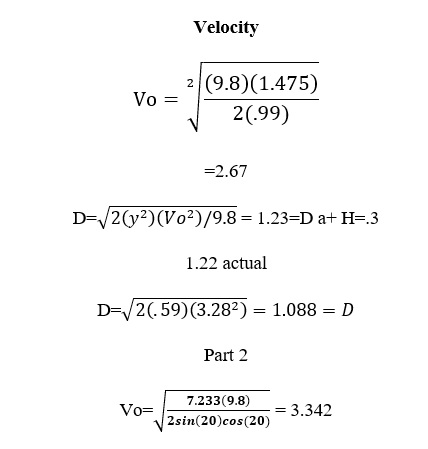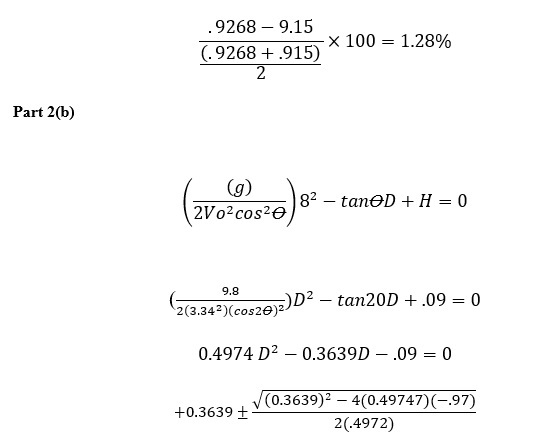PHYS 111A 008 Projectile Motion
PHYS 111A-008
Lab 111: Projectile Motion
Objectives
- To study the projectile motion and apply the linear motion equations to solve this two-dimensional problem.
- To predict where a target of given size should be placed in order to be hit by a projectile leaving a table in a horizontal direction (Part I).
- To measure the range of a projectile leaving table at(measured) angle, and then use this value to predict where the projectile will strike the floor (Part II).
Introduction and background
Part I
- The motion of a projectile is a 2-dimensional motion. In the x-direction, acceleration ax=0 (velocity Vx is constant). In the Y-direction, ay=g directed downwards. There are two separate equations for motion: one in x direction and the other in y direction.
- For a projectile leaving a horizontal surface with a velocity Vo, the distance y below the surface and the horizontal distance x from the surface are given by
- Y=1/2gt^2
- X=Vot
Part II.
If the coordinate axes are chosen such that the origin is at the initial location of the projectile and the +y direction points upward, the following expressions hold for the projectile with an angle relative to horizontal.
- Vx=VoCosꝊo
- Vy=VoSinꝊo-gt
- X=Voxt=(VoCosꝊo)t
- Y=Voyt-1/2gt^2=(VoSinꝊo)t-1/2gt^2
Experimental Setup
Mini Launcher attached onto a base (PASCO, ME-6825), Steel ball (16 mm diameter),Push-rod, C-Clamp, safety glass, Carbon and white papers in a file folder, Scotch tape (on the counter), Ring target with one hole, tripod with right angle clamp to hold the Ring target, Counter tray, Plumb bob, Bubble level.
Data Tables
Table I
|
Trial Number |
1 |
2 |
3 |
4 |
5 |
Average |
|
X |
1.47 |
1.47 |
1.47 |
1.48 |
1.485 |
1.475 |

Table III
Ꝋo=20°
|
Trial Number |
1 |
2 |
3 |
4 |
5 |
Average |
|
R |
.73 |
.73 |
.755 |
.735 |
.735 |
.733 |
Vo=3.342
Table IV
|
Calculated D[cm] |
Measured D[cm] |
%diff |
|
0.9268 |
.915 |
1.28% |

Discussion and Questions
Our prediction with the experimental result is very similar to the values observed. Using these formulas, we were able to predict where the ball would strike as well as to know where the target needed to be placed. The horizontal acceleration is always zero and when the ball was launched at an angle there was a horizontal component of the velocity.
Conclusions
In this lab, we got a better understanding of what projectile motion really is. Our predictions with the experimental result were similar to the values observed. While doing this lab we learned how to use these formulas correctly and through these formulas, we were able to confirm the expected values of displacement and height.


